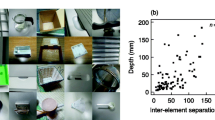Abstract
FISHER1,2 has suggested that spatial information, available in different sensory systems, is analysed according to the operation of a single, centrally organized, mechanism to which all such information is referred. The results of a number of experiments concerned with a variety of features of space perception appear to give general support to this hypothesis. The geometrical illusions have classically been associated with vision. One prediction from the “single mechanism hypothesis” is that these illusions should be perceived as such in other sensory modalities. Accordingly, consideration is being given to the possibility of the geometrical illusions, understood as being examples of systematic distortion or attenuation in the modes of operation of a perceptual classifying system, being observable in senses other than vision.
Similar content being viewed by others
References
Fisher, G. H., Amer. J. Psychol., 75, 321 (1962).
Fisher, G. H., Amer. J. Psychol., 77, 2 (1964).
Burmester, E., Z. Psychol., 12, 355 (1896).
Author information
Authors and Affiliations
Rights and permissions
About this article
Cite this article
FISHER, G. A Tactile Poggendorff Illusion. Nature 212, 105–106 (1966). https://doi.org/10.1038/212105a0
Issue Date:
DOI: https://doi.org/10.1038/212105a0
- Springer Nature Limited
This article is cited by
-
Is the Haptic Müller–Lyer a Visual Phenomenon?
Nature (1971)





